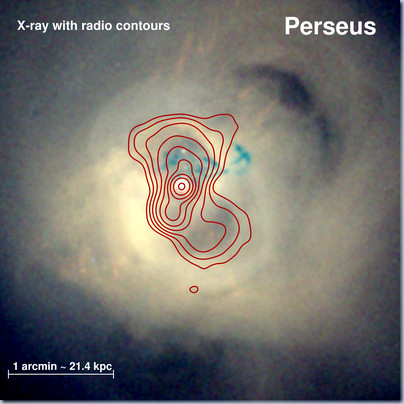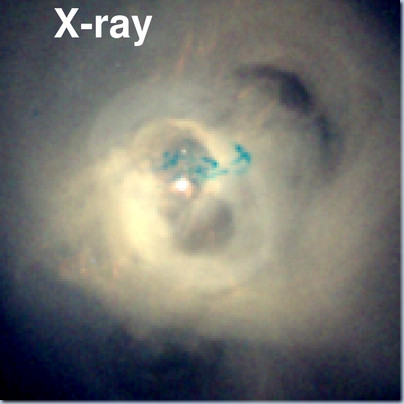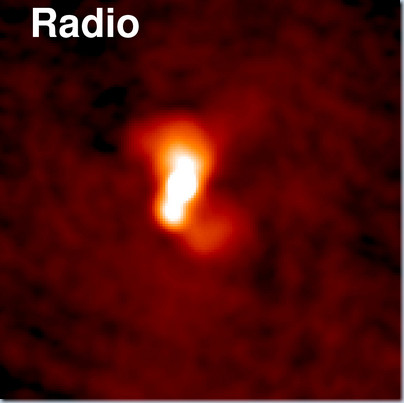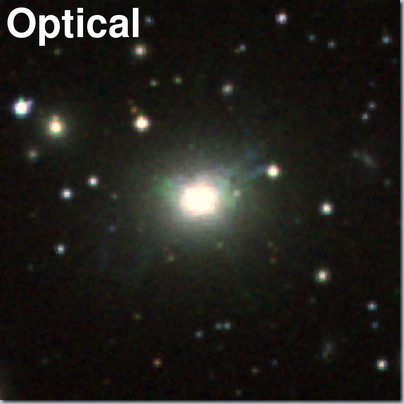|
Old galaxies do not make new stars because black holes overheat their gas.
International experts have reached this conclusion. Dr. Andrea Cattaneo, of
the Astrophysikalisches Institut Potsdam (Germany) brought together a team
of leading scientists from Germany, the USA, the UK, Israel, Canada and
France. The results of three years of discussion on the role of black holes
in the formation and evolution of galaxies are presented in a review article
in the 9th July 2009 issue of the science magazine Nature.
Astronomers have known for a long time that some galaxies make many more
stars than others, but it is only in the last five years that large
observational projects such as the Sloan Digital Sky Survey have confirmed
quantitatively the presence of two separate galaxy populations. There are
old ("early type") galaxies that ceased to make stars long ago and
younger ("late type") galaxies that are still making stars.
"Star-forming galaxies represent the universe's working population",
says Andrea Cattaneo. "Over the duration of their lives, they produce
hundreds of billions of stars, until they finally enter their well-earned
retirement and become passive."
The lack of star formation in early-type galaxies is due not to a lack of
gas but to a lack of cold gas.
Early-type galaxies contain plenty of gas but this gas is very hot.
Therefore, it has too much pressure to condense into stars. Under normal
circumstances, one would expect that this gas should cool and restart making
stars, but observations with the CHANDRA (NASA) and XMM-Newton (ESA) X-ray
satellites have confirmed that only a very small amount of gas is actually
cooling. The black holes that we find at the centre of most galaxies act
like gigantic radiators, which prevent the gas in early-type galaxies from
restarting to make stars. "Without black holes the universe would be a
very different place", says Andrea Cattaneo. "Black holes act like a
cosmic pension fund. During their active lives, galaxies pay a fixed measure
of their mass into central black holes, which later guarantee them a quiet
retirement."
Publication:
A. Cattaneo, S.M. Faber, J. Binney, A. Dekel, J. Kormendy, R. Mushotzky, A. Babul, P.N. Best, M.
Brüggen, A.C. Fabian, C.S. Frenk, A. Khalatyan, H. Netzer, A. Mahdavi, J. Silk, M. Steinmetz & L.
Wisotzki: The role of black holes in galaxy formation and evolution. Nature of July 9, 2009.
The key topics of the AIP are cosmic magnetic fields and extragalactic astrophysics. A considerable part of the institute's efforts aim at the development of research technology in the fields of spectroscopy, robotic telescopes, and e-science. The AIP is the successor of the Berlin Observatory founded in 1700 and of the Astrophysical Observatory of Potsdam founded in 1874. The latter was the world's first observatory to emphasize explicitly the research area of astrophysics.
The AIP is a foundation according to civil law and is a member of the Leibniz Association. The Leibniz Association is a network of 82 independent research institutes and scientific service facilities, which strive for scientific solutions for major social challenges.
Science contact
Dr. Andrea Cattaneo
Astrophysikalisches Institut Potsdam
An der Sternwarte 16
D-14482 Potsdam
(0331) 7499 537

Press contact
Dr. Gabriele Schönherr
Astrophysikalisches Institut Potsdam
An der Sternwarte 16
D-14482 Potsdam
(0331) 7499 383
(0151) 1406 9779

[Press release]
[Programm Area Galaxies]
[AIP home page]
|
|

The Perseus galaxy cluster: Two jets emanating from the central black hole heat up the ambient hot gas. (Images in x-ray, radio, and optical light; A. Cattaneo, AIP)

Perseus galaxy cluster in x-rays.

Perseus galaxy cluster seen in radio waves.

Perseus galaxy cluster seen in the optical light.
|
|
|


 last change 2009 July 8, R. Arlt
last change 2009 July 8, R. Arlt


